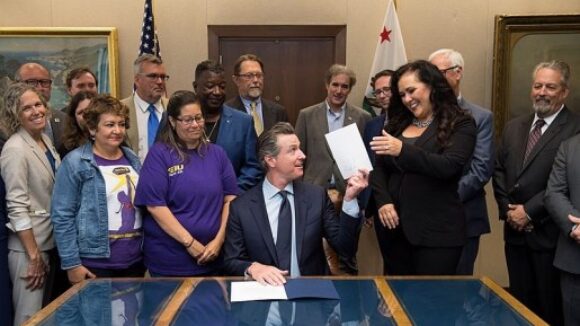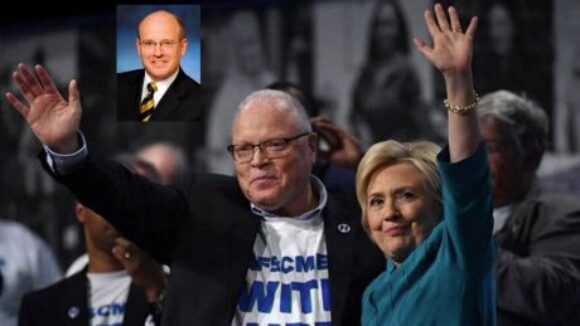‘People Have a Right to Make Their Own Choice’
Avelo employee Kim Howard believes all the firm’s flight attendants should get to vote on continued AFA rule. Credit: WTNH-TV (ABC,…
 Panel Exposes Harm Inflicted by Federally-Imposed Forced Unionism
Panel Exposes Harm Inflicted by Federally-Imposed Forced Unionism
(Click here to download the June 2015 National Right to Work Newsletter)
As this newsletter edition goes to press, the U.S. House Committee on Education and the Workforce is expected to hold an important hearing for which National Right to Work Committee President Mark Mix is submitting written and oral testimony.
The hearing is to assess the harmful repercussions for employees and businesses if President Barack Obama’s appointees on the National Labor Relations Board (NLRB) overturn more than six decades of legal precedents regarding the workplace grievance privileges union officials wield under federal labor law.
In unionized workplaces, a claim by any front-line employee that he or she has been harmed by a misapplication or a misinterpretation of a company policy cannot be addressed in any way that is inconsistent with the contract between the company and Big Labor bosses exercising monopoly-bargaining powers.
Big Labor ‘Owns’ Entire Grievance Process
And federal courts and the NLRB alike have long recognized that union kingpins effectively own the process through which such grievances are handled.
For this reason, both courts and the NLRB have up to now consistently barred Big Labor from charging nonmembers just to get their grievances processed when union members can have their grievances processed for free.
But in mid-April, the Obama NLRB issued a “call for briefs” signaling its intention to reverse board and court precedents going back to 1953 in order to give union chiefs a new tool to eviscerate protections for employee freedom of choice in states with Right to Work laws, now 25 in number.
Section 14(b) of the Taft-Hartley Act clearly provides that federal law does not permit “agreements requiring membership in a labor organization as a condition of employment” wherever “execution or application” of forced-unionism “agreements” is “prohibited” by state or territorial law.
Union Dons Have Long Pushed For a ‘Reinterpretation’ Of Taft-Hartley 14(b)
Committee President Mark Mix noted that avaricious union bigwigs have long sought to cajole federal bureaucrats and jurists into “reinterpreting” Section 14(b) to sanction compelled financial support for unions in every Right to Work state.
Up to now, all such attempts have been unsuccessful.
One notorious case was fueled by a 1961 NLRB ruling that handed Big Labor bosses the power to cut deals with employers forcing Indiana union nonmembers to pay fees equivalent to full union dues, or be fired from their jobs, in spite of the Hoosier State’s Right to Work law.
Subsequently, the Retail Clerks Union and the AFL-CIO tried to expand upon that anti-worker decision, contending before the U.S. Supreme Court that under Section 14(b), states could only prohibit contracts requiring full-fledged union membership as a job condition.
But in their June 1963 decision in Retail Clerks v. Schermerhorn, High Court justices unanimously rejected union lawyers’ petition that they “reinterpret” Section 14(b) to empower them to force union nonmembers in all Right to Work states to pay union fees in order to hold their jobs.
(Indiana’s current Right to Work law, adopted in 2012, explicitly prohibits forced union financial support as well as forced union membership as a condition of employment.)
Lawmakers Can Wield Their ‘Power of the Purse String’ To Rein in Rogue NLRB
Mr. Mix commented:
“To prevent Barack Obama’s NLRB radicals from finally making come true the union hierarchy’s decades-old dream of eviscerating state Right to Work laws, Committee members and supporters are now flooding Capitol Hill with e-mails, phone calls, postcards, petitions and letters.
“In all of these communications, pro-Right to Work citizens are urging their lawmakers not to support any NLRB appropriation for the coming fiscal year unless it includes a rider that blocks the extremist board from imposing forced fees for grievances in Right to Work states.
“Right to Work legislative staffers are reinforcing the message.
“They are asking self-avowed foes of forced unionism in Congress to make it plain to the President they will never back down and send him an NLRB appropriation without a rider blocking the forced-fees-for-grievances scheme.
“Without a doubt, this is an uphill battle. But it is a winnable one.”
Americans in Their Working Years ‘Vote With Their Feet’ For Right to Work
Mr. Mix added that employees’ pay and benefits, as well as their freedom, will be jeopardized if the NLRB carries out its scheme to gut Right to Work protections for the roughly 48% of private-sector employees who now enjoy them or soon will under recently-enacted state laws.
“For many years, working-age Americans have been sending an unmistakable signal that they recognize Right to Work laws are economically beneficial for themselves and their families,” explained Mr. Mix.
“The signal is ‘foot voting.’ And the 84.2 million Americans who were aged 35-54 in 2013 are the group that has sent this message most conspicuously.
“Because they already have plenty of work experience, but are still able to put in a lot of hours on the job, people in this age bracket are commonly characterized by economists as being in their ‘peak earning years.’
“From 2003 to 2013, the number of 35-54 year-olds nationwide fell by 700,000 as a consequence of the ‘baby bust’ of the 1970’s. But nine states still managed to chalk up gains of more than 3% in their peak-earning year population over the same period.
“And all nine of those states — Arizona, Florida, Georgia, Idaho, Nevada, North Carolina, South Carolina, Texas and Utah — have longstanding Right to Work laws.”
Hearing Spurs Hopes For House Floor Vote
“Meanwhile,” Mr. Mix continued, “among the 11 states suffering the steepest declines in their 35-54 year-old population — Alaska, Maine, Michigan, Montana, New Hampshire, Ohio, Pennsylvania, Rhode Island, Vermont, West Virginia and Wisconsin — not one had a Right to Work law prior to 2013.
“With the exceptions of Michigan and Wisconsin, all remain forced-unionism today.
“Overall, from 2003 to 2013, the number of 35-54 year-olds fell by roughly two million, or 4.1%, in the 26 states that lacked Right to Work laws for the whole decade, while the 22 states that had Right to Work protections the entire time experienced a collective increase of 1.7 million, or 5.4%.”
The silver lining of the NLRB’s attack on the Right to Work movement is that it has inadvertently given the U.S. House an opportunity to hold a hearing at which the benefits of voluntary unionism may be considered formally.
If pro-Right to Work members of Congress handle it well, this month’s hearing could even pave the way for House and Senate floor votes on H.R.612 and S.391, national Right to Work measures that would end the manifest injustice of forced union dues and fees in private-sector employment in all 50 states.
Mr. Mix vowed that, in the wake of the hearing, the Committee would redouble its lobbying efforts in support of these two measures, otherwise known as the National Right to Work Act.

Avelo employee Kim Howard believes all the firm’s flight attendants should get to vote on continued AFA rule. Credit: WTNH-TV (ABC,…

California’s Big Labor-concocted A.B.5, signed into law by Gov. Gavin Newsom in 2019, made it almost impossible for workers and firms to bounce back after 2020’s COVID-19 lockdowns. Now Biden bureaucrats want to federalize A.B.5!

Mr. Fain undoubtedly knows full well that there is a complete disconnect between the UAW hierarchy and the UAW rank-and-file on the Biden presidency and whether workers will benefit from its extension for another four years.